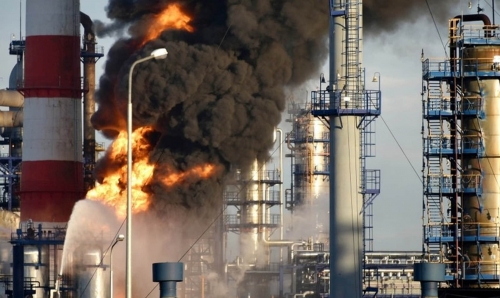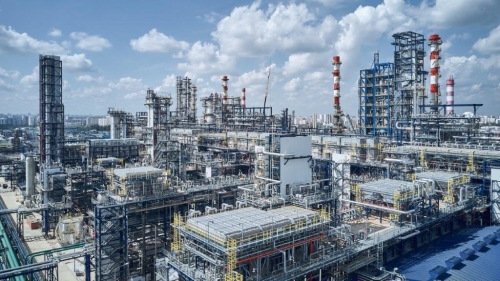Amid continued Middle East ceasefire talks and a sobering correction to US jobs data, oil prices were on track to their steepest weekly decline in a while, with a late week save by hopes of an imminent Fed rate cut.
Gas prices on the Henry Hub declined this week, after previous forecasts for hotter weather were rolled back and the EIA reported a 35 Bcf week-on-week growth in storage levels, much more than expected.
BKR Rig Count | The total active drilling rigs in the United States decreased by 1 last week, to 585. Oil rigs remained flat at 483, and gas rigs dropped by 1 to 97. Rig count in the Permian Basin increased by 3 to 306 | Aug 23 | BKR NAM Rig Count
US Crude Inventories, excluding those in the Strategic Petroleum Reserve (SPR), decreased by 4.6 MMbbl to 426.0 MMbbl (about 5% below the 5y average for this time of year). On the products side, gasoline decreased by 1.6 MMbbl (3% below the 5y average). Distillate fuels decreased by 3.3 MMbbl (10% below the 5y average). Total commercial petroleum inventories decreased by 5.9 MMbbl | Aug 16 | EIA Weekly Report
Norway calls on oil firms to boost exploration and production as many of its largest offshore fields are in decline and there are currently no new developments scheduled for the 2030s. NOD expects the country's oil and gas output to peak in 2025, citing that “More exploration and investment in fields, discoveries and infrastructure must therefore be made if the decline in production is to be slowed down." In January, the NOD said it expected oil and gas investments to fall to 193 billion Norwegian crowns ($18.37 billion) in 2028 from 240 billion crowns in 2024 | Aug 21 | Reuters
Iran's new Petroleum Minister has taken charge, says oil production to rise by 400k bpd by Mar 2026 | Aug 23 | Upstream
Chair Jerome Powell said the time has come for the Federal Reserve to cut its key policy rate and made clear his intention to prevent further cooling in the labor market. He outlined two priorities for the months ahead: keeping the US economy afloat while also taking a closer look at what went wrong over the past few years, previewing what will be the Fed’s first formal review of its strategy. The European Central Bank has also already begun a similar review, where ECB President Christine Lagarde said the exercise could have significant implications for future rate decisions and the ECB’s response to crises | Aug 25 | Bloomberg
China hits Xi Jinping’s renewable power target six years early | China added 25 gigawatts of turbines and panels in July and surpassed its wind and solar generating capacity target of 1,200 gigawatt by 2030. The rapid growth has helped lead to declines in coal power generation this summer and may mean that China has already reached peak emissions well before its 2030 target. Still, solar and wind have only generated about 14% of the country’s electricity so far this year. The nation’s grid operators are also investing heavily in power lines and energy storage facilities to be able to handle all of the intermittent generation | Aug 22 | Bloomberg
Modern ‘shadow’ LNG carrier heads to China with Russian cargo | A newbuild Arc4 liquefied natural gas carrier on charter to Russia’s Novatek has completed a laden passage through the Arctic waters of the Northern Sea Route (NSR) to deliver a shipment of LNG to China | Aug 20 | Upstream
Malaysia’s Petronas has asked customers to accept delays to some scheduled shipments of LNG because of a new outage at part of its export facility, shifting supplies from Q4 2024 to 2025. The Bintulu LNG plant has had repeated issues this summer resulting in several cargoes already being deferred to later periods. The outages come as summer demand in North Asia remains high, and with the plant’s annual production capacity of 30 mtpa, such supply disruptions weigh on global prices, especially when geopolitical factors are also playing out | Aug 22 | Bloomberg
Strong wind and solar output is pushing power prices across Europe to negative levels as milder weather weakens demand. Average weekly wind generation is forecast to total 14.7 gigawatts — more than double the 5-year average, according to Bloomberg models. Summer months usually see strong solar generation, but an uptick in wind is less common, highlighting the uncertainty surrounding renewable sources of electricity. Negative prices are occurring more frequently and are a symptom of a system that can’t match intermittent supply with demand. Suppressed prices spurred French nuclear operator Electricite de France SA to shut off one of its power plants until at least Aug. 23 because it considered production not economically viable | Aug 22 | Bloomberg
Financing Push Aims to Unlock Billions to Curb Methane Leaks | A global group of about 50 organizations including the Climate Bonds Initiative and the IEA are working on new guidelines that could enable oil and gas producers seeking to reduce their methane emissions to access transition financing. The non-profit, which assesses sustainable debt, intends to release funding recommendations at COP 29 where they could then certify methane reduction projects that meet the criteria | Aug 22 | Bloomberg
Hungary said refiner Mol Nyrt. is discussing a workaround to receive crude from Russia’s Lukoil PJSC via Ukraine, possibly in the coming months, though that’s expected to result in increased transport costs. Under the deal being discussed, costs of transport via Ukraine are expected to rise by around $1.50 a barrel due to higher security risks and related insurance, according to Hungarian Cabinet Minister Gergely Gulyas | Aug 22 | Bloomberg
Potential Israel-Hezbollah Escalation could Push Egypt and Jordan to Seek Emergency LNG Volumes | An increase in attacks since late July 2024 has raised the likelihood of an escalation to all-out war between Israel and Hezbollah. A direct conflict would likely prompt Israel to temporarily shut down gas production at some or all of its offshore gas fields due to the threat of missile and UAV attack, which would in turn cut off pipeline gas supply from Israel to Egypt and Jordan. Egypt’s rapidly declining domestic gas production has returned it to significant LNG imports in 2024, but it would need to adjust to the critical loss of around 900 MMcf/d in Israeli pipeline gas. Jordan is nearly entirely dependent on the roughly 300 MMcf/d it receives from Israel and would also likely seek LNG to replace lost volumes. However, between the two nations’ interconnected LNG infrastructure, capacity would initially be insufficient to fully replace the lost pipeline volumes due to existing LNG import demand. The two countries would likely only have sufficient spare capacity to fully replace the lost gas via LNG by the end of Q4 with potential incremental demand totaling just under 2% of global LNG trade. Iran’s retaliation for the assassination of Hamas leader Ismail Haniyeh in Tehran will probably be calibrated to avoid drawing Iran into a direct major conflict with sustained strikes on its territory. However, if the conflict expands into direct war between Iran and Israel, one probable impact would be Iranian attacks on shipping in the Persian Gulf and the Strait of Hormuz. As around 21% of global LNG trade passes through these waters, any such disruption, even if it were to last less than a month, would tighten the LNG market significantly | Aug 21 | S&P
S&P Q2 2024 Update on Hydrogen Production with Carbon Capture and Sequestration | Global capacity in advanced planning, which includes projects that have started FEED, doubled in second quarter 2024 from 3.7 MMt/y of hydrogen to 7.5 MMt/y. Increasing FEED work is driven by the finalization of H2 with carbon capture, utilization and sequestration (CCUS) policy and regulation in the US and East Asia. Capacity is concentrated in emerging CCUS clusters on the US Gulf Coast and around the North Sea. 85% of globally announced capacity is in the US, Canada and countries that border the North Sea. Project risk-weighted outlook shows 8.4 MMt/y of H2 capacity will be reached by end-2030, up from less than 0.5 MMt/y today. Japan finalized the “Hydrogen Society Promotion Act,” officially budgeting $20 billion for clean hydrogen development. The country’s energy ministry tightened clean hydrogen and ammonia life-cycle emissions measurement and reporting requirements to include upstream and midstream methane emissions. Import contract-for-difference subsidy auctions are expected to open in Japan and Korea in fourth quarter 2024. On the US market, the US Supreme Court’s decision in Loper Bright introduces new regulatory uncertainty into the US clean hydrogen market. S&P does not expect this to delay CCUS projects that are opting to receive 45Q CO2 sequestration tax credits. By contrast, electrolysis and other projects relying on 45V tax credits likely will be delayed | August 2024 | S&P
China cuts back on new permits for coal-fired power projects as the rapid take-up of clean energy proves sufficient to meet consumption growth in electricity. Just 9 gigawatts of coal power was permitted in the first half of this year, 83% less than the same period in 2023, according to a joint study released by the Centre for Research on Energy and Clean Air. Still, the pipeline for coal-power remains substantial — and a threat to China’s climate goals — with annual permits exceeding 100 GW in both 2022 and 2023, the study found. Over 41 GW of coal plants were under construction in the first half of 2024, more than 90% of the total being built around the world. “With clean power now capable of meeting the country’s electricity demand growth, China should cancel its remaining coal proposals and accelerate the retirement of its existing coal plants,” said Christine Shearer, a research analyst at GEM. Instead, China is expanding its coal fleet, already the world’s largest, as a backstop to its record-breaking deployment of renewables like wind and solar, which offer only intermittent power. But the plants are expensive and designed to last decades, and environmentalists are concerned that coal consumption is being set up to plateau, when the climate crisis demands that usage should plunge. Greenpeace East Asia, which has reported similar data on new permits, said it’s an open question whether approvals are slowing only because the pipeline is so stuffed, or whether a turning point in the energy transition has been reached as coal becomes an “increasingly impractical” power source | Aug 21 | Bloomberg

%20(1).png)



